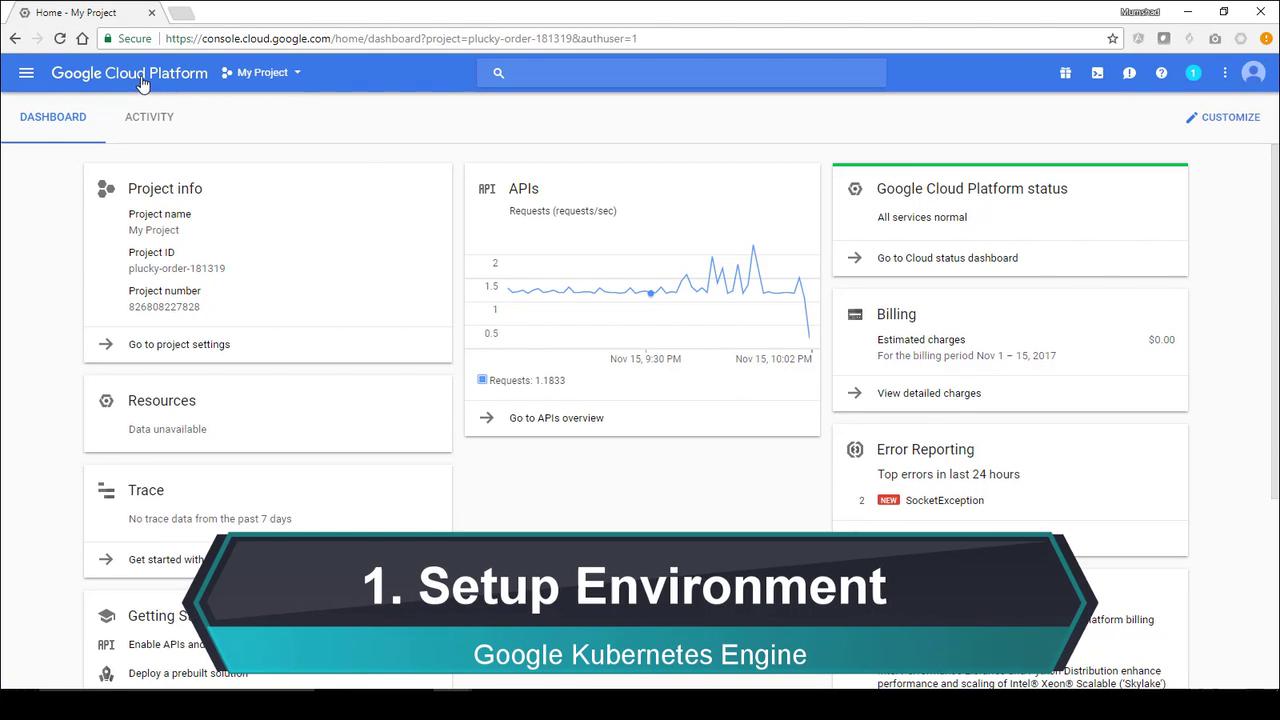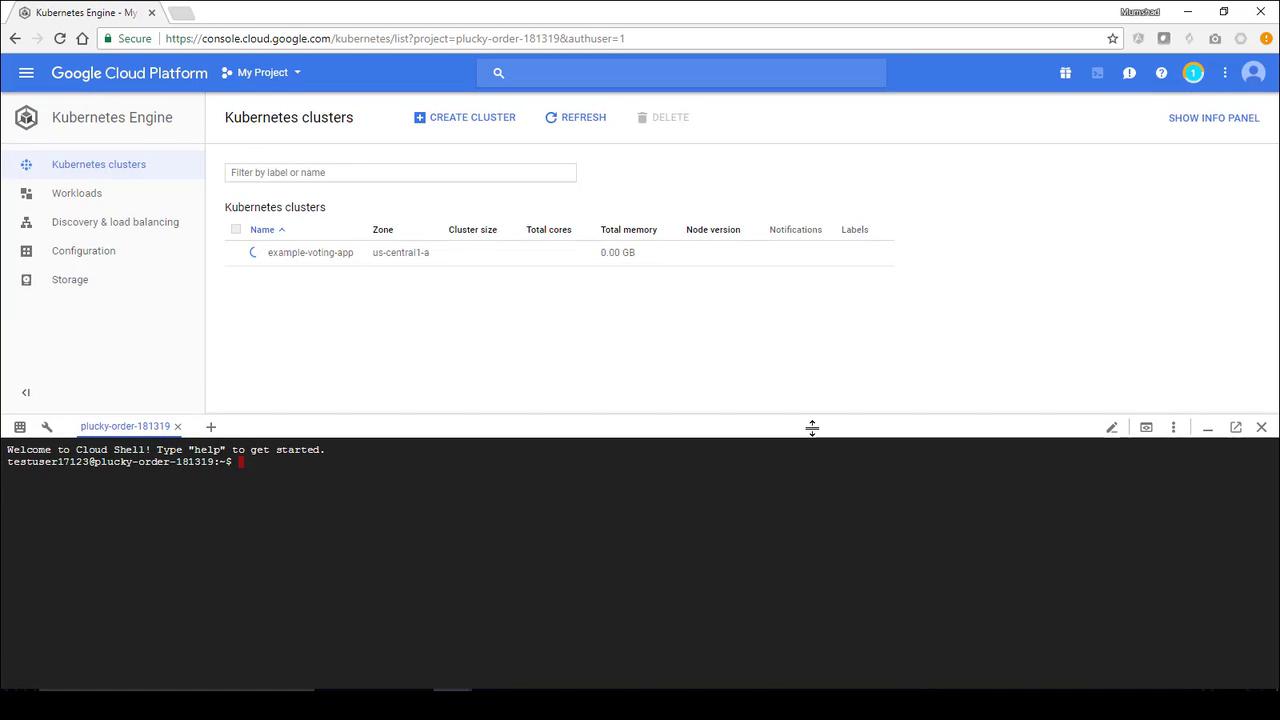Docker - SWARM | SERVICES | STACKS - Hands-on
Kubernetes Introduction
Demo Kubernetes on Google Cloud Platform
Welcome to this comprehensive guide on deploying an application using Google Kubernetes Engine (GKE) on the Google Cloud Platform (GCP). In this article, you'll learn how to set up a Kubernetes cluster, create YAML definition files for pods and services, and deploy your multi-component application. Follow along as we walk through each step of the process.
Setting Up the Kubernetes Cluster
Begin by signing in to your Google Cloud Platform account. Once logged in, your dashboard will resemble the image below:

Kubernetes Engine provides a managed environment for deploying containerized applications. To get started with the command-line tool, run:
gcloud components install kubectl
Next, from the Cloud Console menu, select Kubernetes Engine to access the dashboard. If no cluster exists yet, click on Create a Cluster as shown below:

Fill in the cluster details:
- Name: Use something descriptive like "example-voting-app"
- Description: (Optional) Provide a brief description
- Leave the remaining options as default and click Create.
This process provisions a master node along with three worker nodes. When setup is complete, you will see a green check mark confirming the cluster is ready.
Next, click on the Google Cloud Shell button located in the top right corner. The Cloud Shell offers a temporary terminal for running Kubernetes commands and will display a screen similar to the one below:

Once your cluster is ready, click the Connect button for the Voting Application cluster. Follow the provided instructions to retrieve credentials and start a proxy by running:
gcloud container clusters get-credentials example-voting-app --zone us-central1-a --project plucky-order-181319
kubectl proxy
Note
If the command warns that the cluster is not running, wait until the green check mark appears and execute the command again. This step ensures that your kubeconfig is correctly configured for further commands.
To verify your cluster, list the nodes:
kubectl get nodes
You should see something similar to the following output:
NAME STATUS ROLES AGE VERSION
gke-example-voting-app-default-pool-2aad9e6c-d9n5 Ready <none> 1m v1.7.8-gke.0
gke-example-voting-app-default-pool-2aad9e6c-ldq4 Ready <none> 1m v1.7.8-gke.0
gke-example-voting-app-default-pool-2aad9e6c-x9pp Ready <none> 1m v1.7.8-gke.0
Similarly, verify that no pods are running yet:
kubectl get pods
You can also list the Kubernetes-created default service with:
kubectl get services
With your cluster ready, the next step is to create YAML definition files for the application components.
Creating Pod Definition Files
On your local development environment, create a folder called example-voting-app-kube. This folder will contain the YAML files for each component of the voting application.
Voting App Pod
Create a file named voting-app-pod.yaml with the following content:
apiVersion: v1
kind: Pod
metadata:
name: voting-app-pod
labels:
name: voting-app-pod
app: demo-voting-app
spec:
containers:
- name: voting-app
image: dockersamples/examplevotingapp_vote
ports:
- containerPort: 80
This definition creates a pod for the voting application. The labels will be used later for service selection.
Worker Pod
Duplicate the previous file and save it as worker-app-pod.yaml. Modify the content as follows:
apiVersion: v1
kind: Pod
metadata:
name: worker-app-pod
labels:
name: worker-app-pod
app: demo-voting-app
spec:
containers:
- name: worker-app
image: dockersamples/examplevotingapp_worker
This pod definition creates the backend worker, which does not require exposed ports.
Result App Pod
Create a file named result-app-pod.yaml containing:
apiVersion: v1
kind: Pod
metadata:
name: result-app-pod
labels:
name: result-app-pod
app: demo-voting-app
spec:
containers:
- name: res-app
image: dockersamples/examplevotingapp_result
ports:
- containerPort: 80
This pod exposes port 80 for the results application.
Redis Pod
Define the Redis pod by creating a file named redis-pod.yaml:
apiVersion: v1
kind: Pod
metadata:
name: redis-pod
labels:
name: redis-pod
app: demo-voting-app
spec:
containers:
- name: redis
image: redis
ports:
- containerPort: 6379
Redis listens on the default port 6379.
PostgreSQL Pod
Finally, create a file named postgres-pod.yaml for the PostgreSQL database:
apiVersion: v1
kind: Pod
metadata:
name: postgres-pod
labels:
name: postgres-pod
app: demo-voting-app
spec:
containers:
- name: postgres
image: postgres:9.4
ports:
- containerPort: 5432
PostgreSQL uses port 5432.
Creating Service Definition Files
To allow the components to communicate internally (and externally when needed), you'll create services for the pods.
Redis Service
Create a file named redis-service.yaml with this content:
apiVersion: v1
kind: Service
metadata:
name: redis
labels:
name: redis-service
app: demo-voting-app
spec:
ports:
- port: 6379
targetPort: 6379
selector:
name: redis-pod
app: demo-voting-app
This service exposes the Redis pod internally.
PostgreSQL (DB) Service
For the PostgreSQL database, create a file named postgres-service.yaml:
apiVersion: v1
kind: Service
metadata:
name: db
labels:
name: db-service
app: demo-voting-app
spec:
ports:
- port: 5432
targetPort: 5432
selector:
name: postgres-pod
app: demo-voting-app
The service is named "db" to match what the application expects.
Voting App Service (LoadBalancer)
To expose the voting application externally, create a file named voting-app-service.yaml:
apiVersion: v1
kind: Service
metadata:
name: voting-service
labels:
name: voting-service
app: demo-voting-app
spec:
type: LoadBalancer
ports:
- port: 80
targetPort: 80
selector:
name: voting-app-pod
app: demo-voting-app
Setting the service type to LoadBalancer enables external access through a cloud provider’s load balancer.
Result App Service (LoadBalancer)
Similarly, expose the result app externally by creating result-service.yaml:
apiVersion: v1
kind: Service
metadata:
name: result-service
labels:
name: result-service
app: demo-voting-app
spec:
type: LoadBalancer
ports:
- port: 80
targetPort: 80
selector:
name: result-app-pod
app: demo-voting-app
Tip
Although service labels can sometimes be optional, it is best practice to define them consistently for ease of management.
Deploying to the Cluster
Before deployment, commit and push your YAML files to your GitHub repository. Then, open your Cloud Shell and clone your repository:
- Clone the Repository:
git clone <repository-url>
- Change into the Directory:
cd kubernetes-example-voting-app
Now, deploy each component individually.
Deploy the Voting App
- Create the Voting App Pod:
kubectl create -f voting-app-pod.yaml
You should receive a confirmation such as:
pod "voting-app-pod" created
- Verify Pod Status:
kubectl get pods
- Expose the Voting App:
kubectl create -f voting-app-service.yaml
Check the service details. Initially, the external IP might be listed as <pending>:
kubectl get services
Monitor the load balancer creation in the "Discovery and load balancing" section of the Cloud Console. Once the external IP is provisioned, you can access the voting app in your browser.
Deploy Internal Components
Deploy Redis and its corresponding service:
kubectl create -f redis-pod.yaml
kubectl create -f redis-service.yaml
Similarly, deploy the PostgreSQL pod and its service:
kubectl create -f postgres-pod.yaml
kubectl create -f postgres-service.yaml
Deploy the Worker and Result Pods
Deploy the worker component with:
kubectl create -f worker-app-pod.yaml
Then deploy the result application pod and expose it externally:
kubectl create -f result-app-pod.yaml
kubectl create -f result-service.yaml
To review the status of your pods:
kubectl get pods
And to check your services, run:
kubectl get services
A typical output might look like this:
| NAME | TYPE | CLUSTER-IP | EXTERNAL-IP | PORT(S) | AGE |
|---|---|---|---|---|---|
| db | ClusterIP | 10.19.245.11 | <none> | 5432/TCP | 2m |
| kubernetes | ClusterIP | 10.19.240.201 | <none> | 443/TCP | 25m |
| redis | ClusterIP | 10.19.242.155 | <none> | 6379/TCP | 3m |
| result-service | LoadBalancer | 35.188.172.125 | 35.184.173.162 | 80:30410/TCP | 12s |
| voting-service | LoadBalancer | 35.184.173.162 | <pending> | 80:30176/TCP | 6m |
Once the load balancer services are active and the external IP addresses are available, simply enter those IPs in your browser. As you cast votes, you will see the results update in near real-time.
Conclusion
This guide demonstrated how to create a Kubernetes cluster on Google Cloud Platform, prepare YAML files for various pods and services, and deploy a multi-component application encompassing the voting app, worker, result app, Redis, and PostgreSQL. Services are configured to ensure seamless communication between components as well as external access via load balancers.
Thank you for reading this guide. Enjoy experimenting with Kubernetes and GCP, and happy deploying!
For further reading, consider exploring the following resources:
Happy Kubernetes-ing!
Watch Video
Watch video content